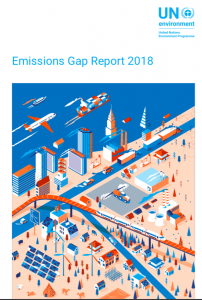UNEP: Emissions Gap Report 2018
This is the 9th edition of the UN Environment Emissions Gap Report. It assesses the latest scientific studies on current and estimated future greenhouse gas emissions and compares these with the emission levels permissible for the world to progress on a least-cost pathway to achieve the goals of the Paris Agreement. This difference between “where we are likely to be and where we need to be” is known as the ‘emissions gap’. As in previous years, the report explores some of the most important options available for countries to bridge the gap.
The political context this year is provided by several processes and events:
- The Talanoa Dialogue – an inclusive, participatory and transparent dialogue about ambitions and actions, conducted under the auspices of the United Nations Framework Convention on Climate Change (UNFCCC) and designed to help build momentum for new or updated Nationally Determined Contributions (NDCs) to be submitted by 2020.
- The Global Climate Action Summit in September 2018 – bringing together many non-state and subnational actors (NSAs) that are actively involved in climate issues.
- The Intergovernmental Panel on Climate Change (IPCC) Special Report on Global Warming of 1.5°C – focusing on “the impacts of global warming of 1.5°C above pre-industrial levels and related global greenhouse gas emission pathways, in the context of strengthening the global response to the threat of climate change, sustainable development, and efforts to eradicate poverty”.
The Emissions Gap Report has benefited significantly from the IPCC Special Report and its underlying studies. This Emissions Gap Report has been prepared by an international team of leading scientists, assessing all available information, including that published in the context of the IPCC Special Report, as well as in other recent scientific studies. The assessment production process has been transparent and participatory. The assessment methodology and preliminary findings were made available to the governments of the countries specifically mentioned in the report to provide them with the opportunity to comment on the findings.
Download the full report here.





